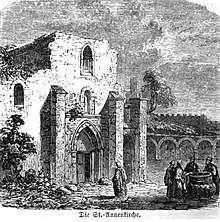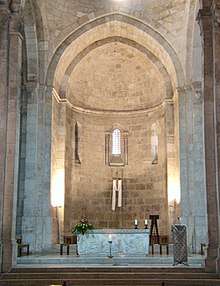Church of Saint Anne, Jerusalem
The Church of Saint Anne (French: Église Sainte-Anne, Latin: Ecclesia S. Anna, Arabic: كنيسة القديسة حنة, Hebrew: כנסיית סנטה אנה) is a French Roman Catholic church and French national domain[1] located at the start of the Via Dolorosa, near the Lions' Gate and churches of the Flagellation and Condemnation, in the Muslim Quarter of the Old City of Jerusalem.
| Church of Saint Anne French: Église Sainte-Anne Latin: Ecclesia S. Anna Arabic: كنيسة القديسة حنة Hebrew: כנסיית סנטה אנה | |
|---|---|
Exterior view | |
| Religion | |
| Affiliation | Roman Catholic |
| Leadership | White Fathers |
| Location | |
| Location | Old City of Jerusalem |
| Architecture | |
| Type | Romanesque |
| Completed | 1138 |
History of the site
During the Roman Period a pagan shrine to either the Egyptian god Serapis or the Roman god Asclepius, both gods of healing, stood on the grounds next to the two Pools of Bethesda.[2]
A Byzantine basilica was built over the remains of the shrine in the 5th century. Partially destroyed by the Persians in 614, it was subsequently restored.[3] Baldwin I, the first titled Crusader king of Jerusalem, banished his wife Arda to the old Benedictine convent which still existed here in 1104.[2] A small Crusader church, the so-called Moustier, was then erected over an extension of the northern Pool of Bethesda.

The actual Church of St Anne was built sometime between 1131 and 1138, during the reign of Queen Melisende. It was erected near the remains of the Byzantine basilica, over the site of a grotto believed by the Crusaders to be the childhood home of the Virgin Mary, mother of Jesus. It is dedicated to Anne and Joachim, the parents of Saint Mary, who according to tradition lived here.[4]
Unlike many other Crusader churches, St. Anne's was not destroyed after Ṣalāḥ ad-Dīn's 1187 conquest of Jerusalem. In 1192 Ṣalāḥ ad-Dīn, known in the West as Saladin, converted the building into a madrasa (Islamic educational institution),[3] known as al-Madrasa as-Salahiyya (of Saladin), as is still written in the Arabic inscription above the entrance. In the 15th century it was considered as the most prestigious college in the city, counting among its more prominent students the Islamic jurist and city historian Mujir al-Din (1456–1522).
During the renewed Muslim Ottoman rule of Palestine, Christian pilgrims were only permitted inside the grotto after paying a fee. Eventually the madrasa was abandoned and the former church building fell into disrepair.
In 1856, in gratitude for French support during the Crimean War, the Ottoman Sultan Abdülmecid I presented it to Napoleon III. It was subsequently restored, but the majority of what remains today is original. The French government claims St. Anne belongs to the French government. Since 1878, it has been administered by the Missionaries of Africa, a catholic order, commonly called "The White Fathers", for the colour of their robes.[3] Between 1882 and 1946, the site housed a seminar for the training of Greek-Catholic priests.

Design and construction
Built between 1131 and 1138 to replace a previous Byzantine church, and shortly thereafter enlarged by several meters, the church is an excellent example of Romanesque architecture.[2] The three-aisled basilica incorporates cross-vaulted ceilings and pillars, clear clean lines and a somewhat unadorned interior. The nave is separated from the lower lateral aisles by arcades of arches. The high altar, designed by the French sculptor Philippe Kaeppelin incorporates many different scenes. On the front of the altar are depicted the Nativity (left), the Descent from the Cross (center) and the Annunciation (right); on the left-hand end is the teaching of Mary by her mother, on the right-hand end her presentation in the Temple.[5] In the south aisle is a flight of steps leading down to the crypt, in a grotto believed by the Crusaders to be Mary's birthplace. An altar dedicated to Mary is located there. The Byzantine basilica was partly stretched over two water basins, collectively known as the Pools of Bethesda, and built upon a series of piers, one of which still stands today in its entirety.
Acoustics
The church's acoustics are particularly suited to Gregorian chant, which makes it a pilgrimage site for soloists and choirs.[6]
French claim
French presidents have claimed that the church is under French protection, owned by its government, and is listed as 1 of 4 properties of the Holy Land in the "Domaine national français". In 1996, during Jacques Chirac’s visit to Jerusalem, the French president refused to enter the church until Israeli soldiers who accompanied him left. Similarly in January 2020, French President Emmanuel Macron was involved in an altercation with Israeli security officers at the church.[7] The French claim seems to be based on the Fischer-Chauvel Agreement of 1948, if not based on an earlier basis. However, the Fischer-Chauvel Agreement was never ratified by Israel.
References
- Mochon, Jean-Philippe (1996). "Le Consul Général de France à Jérusalem ; aspects historiques, juridiques et politiques de ses fonctions". Annuaire Français de Droit International. 42 (1): 935. doi:10.3406/afdi.1996.3421.
- Murphy-O'Connor, Jerome (28 February 2008). The Holy Land: An Oxford Archaeological Guide from Earliest Times to 1700. OUP Oxford. pp. 29–31. ISBN 9780191528675.
- Buholzer, Joe; Macleod, Donald. "The White Fathers' Community at St. Anne's, Jerusalem". The Missionaries of Africa. Archived from the original on 4 October 2017. Retrieved 30 April 2018.
- Yudin, Joe (17 November 2011). "Off the Beaten Track: The Church of St. Anne". Jerusalem Post. Jpost Inc. Retrieved 30 April 2018.
- Rogoff, Mike (12 August 2013). "Tourist Tip #310 / The Church of St. Anne". Haaretz. Retrieved 29 April 2018.
- "Church of St. Anne". Faith ND. University of Notre Dame. Retrieved 29 April 2018.
- Andrew Carey; Saskya Vandoorne. "Emmanuel Macron shouts at Israeli security officers in altercation in Jerusalem". CNN. Retrieved 2020-01-23.
Bibliography
- Clermont-Ganneau, C.S. (1899). [ARP] Archaeological Researches in Palestine 1873-1874, translated from the French by J. McFarlane. 1. London: Palestine Exploration Fund. (pp. 116 - 126)
- Fabri, F. (1896). Felix Fabri (circa 1480–1483 A.D.) vol I, part II. Palestine Pilgrims' Text Society. (pp. 455, 483)
- Moudjir ed-dyn (1876). Sauvaire (ed.). Histoire de Jérusalem et d'Hébron depuis Abraham jusqu'à la fin du XVe siècle de J.-C. : fragments de la Chronique de Moudjir-ed-dyn. (pp. 77, 82, 154-5)
- Pococke, R. (1745). A description of the East, and some other countries. 2. London: Printed for the author, by W. Bowyer. (p. 14)
- Poloner, John (1894). John Poloner's description of the Holy Land (ca. A.D. 1421). Palestine Pilgrims' Text Society. (p. 6)
- Pringle, Denys (2007). The Churches of the Crusader Kingdom of Jerusalem: The city of Jerusalem. III. Cambridge University Press. ISBN 978-0-521-39038-5. (pp. 142- 156)
- Vogüé, de, M. (1860). Les églises de la Terre Sainte.(p. 233-245; pl. XIV-XXV)
- Warren, C.; Conder, C.R. (1884). The Survey of Western Palestine: Jerusalem. London: Committee of the Palestine Exploration Fund. (pp. 40, 83, 428)
